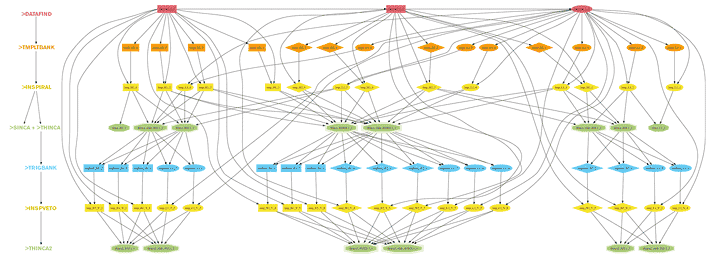Deconstruction: LIGO analysis
>DATAFIND: Data from each of LIGOs three detectors, H1 and H2 from Washington, and L1 from Louisiana, are distributed across six LIGO computing centers. Datafind jobs query catalogs to locate needed data. The depicted inspiral workflow is performed on every 2048-second parcel (about 34 minutes) of data.
>TMPLTBANK: Using parameters such as mass and spin, and accounting for detector sensitivity, theoretical models are used to make a bank of expected waveforms, or templates, for binary inspiral events.
>INSPIRAL: Data recorded by LIGO are compared with the waveforms in the template bank and those that match within some statistical threshold are stored for further analysis.
>SINCA + >THINCA: Programs look for coincident events, observed at the same time and with the same mass parameters in two or more detectors.
>TRIGBANK: The events that survive in coincidence from the Thinca program are converted back into template waveforms.
>INSPVETO: Additional tests are performed to verify that the data matches a template waveform. These tests are computationally costly, so they are only performed on can-didate events observed in at least two detectors.
>THINCA2: The coincidence step is repeated to find a final list of candidate events. The result of the series of programs is an upper limit on the expected rate of binary inspiral events within the surveyed portion of the galaxy. Once the statistics are calculated using the workflow, LIGO scientists begin to interpret the results. LIGO has performed four science runs since 2002 with the fifth scheduled for late 2005, during which the LIGO instruments will operate at design sensitivity and will collect one year of observational data.
Text: Kendra Snyder
Click here to download the pdf version of this article.







